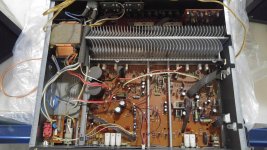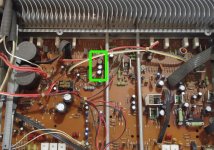I have an NAD 3155, been a great unit for 15+years. I run the unit bridged and as of late - the protection circuit is coming in way to soon. I run a 2155 bridged as well and give me a basis for comparision. Any ideas on what to tackle to repair?
I have read on a few threads about upgrading certain components in this unit - any write ups on the mods needed ?
Thanks
Derek Atkin
I have read on a few threads about upgrading certain components in this unit - any write ups on the mods needed ?
Thanks
Derek Atkin
I started this post in 2007, never got any responses so I put the component away. Dug it out and would like to see if I can get it running. Did some more diagnostic and here is what I found:
I have an NAD 3155 that is kicking in the protection circuit at mild volume levels. Here is what I have discovered.
- Protection circuit comes in with speaker outputs turned off
- With balance all the way to the left speaker I can play the amplifier quite loud.
- 4/8 ohm switch doesn't impact the problem
- Sound quality doesn't seem affected
Any thoughts on what to look at?
Thanks
Derek.-
I have an NAD 3155 that is kicking in the protection circuit at mild volume levels. Here is what I have discovered.
- Protection circuit comes in with speaker outputs turned off
- With balance all the way to the left speaker I can play the amplifier quite loud.
- 4/8 ohm switch doesn't impact the problem
- Sound quality doesn't seem affected
Any thoughts on what to look at?
Thanks
Derek.-
Attachments
Try replacing C713 and C707 for LH and repeat for RH, they are in a similar place, but not shown on my schematic
Check the right channel amp for resistors gone high and bad solder joints, starting from the output. Stuff like that can throw off DC offset under load, with the result of protection kicking in like you're seeing.
So both channel came to life after I touched a number of the caps on the main board. Maybe an unorthodox method of diagnosis but I took a tongue depressor and touched the caps while the unit was running. Found a few bad cold solder joints.
After a touch up with the soldering iron its back up and running.
Cleaned all the pots and adjusted the dc voltage and it should be good for a while.
After a touch up with the soldering iron its back up and running.
Cleaned all the pots and adjusted the dc voltage and it should be good for a while.
Attachments
If there are older amps for service, this is still the best way before start the actually troubleshooting. At least the caps arround the Toshiba protector unit TA7317 (the part in SIP-outline in left of the marked area in your image of previous posting) and all electrolytic caps near by parts, which are under thermal stress.So both channel came to life after I touched a number of the caps on the main board. Maybe an unorthodox method of diagnosis but I took a tongue depressor and touched the caps while the unit was running. Found a few bad cold solder joints.
After a touch up with the soldering iron its back up and running.
Cleaned all the pots and adjusted the dc voltage and it should be good for a while.
In this amp model there are also two burned PCB areas (dark PCB areas) near by two high wattage resistors. This resistors runs too hot. Please replace this resistors through 17 watt versioins with larger surface or use 10 resistors in parallel mode (instead only a single resistor as in use in genuine condition) with 10-times of the ohm value. Then you will get an additional enhanced reliability.
"Please replace this resistors through 17 watt versioins with larger surface or use 10 resistors in parallel mode (instead only a single resistor as in use in genuine condition) with 10-times of the ohm value".
NOT recommended. This is a bodge and should be discouraged!
Replace the resistors, if they are faulty which doubt and use high temperature solder.
They have been there for a long time and will continue for a further long time.
NOT recommended. This is a bodge and should be discouraged!
Replace the resistors, if they are faulty which doubt and use high temperature solder.
They have been there for a long time and will continue for a further long time.
These amps almost never work right and the fault is always the solder joints. Barely touching it with a hot iron will make it disappear into thin air. Even the traces can easily break off. Super bad quality.
The PCB is clearly charred and no one can seriously claim that the amplifier should continue to work in that state. It is paper/phenolic laminate which will now be conductive, simply because the resistors have run too hot for too long in close proximity.......They have been there for a long time and will continue for a further long time.
However clever and so much cheaper it is to run components close to their design limits and however long they may survive that way, it is still a bad design if the heat normally produced destroys its support materials and circuitry. If design principles for high-rel, life support or mil. spec. assemblies were prepared along those lines, the products thankfully, wouldn't even get to prototype stage 🙁
- Status
- Not open for further replies.
- Home
- Amplifiers
- Solid State
- Overactive NAD 3155 Protection Circuit

